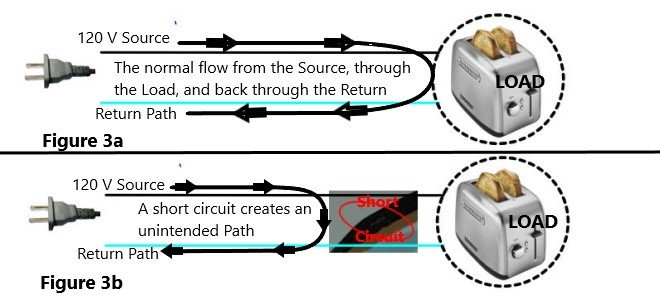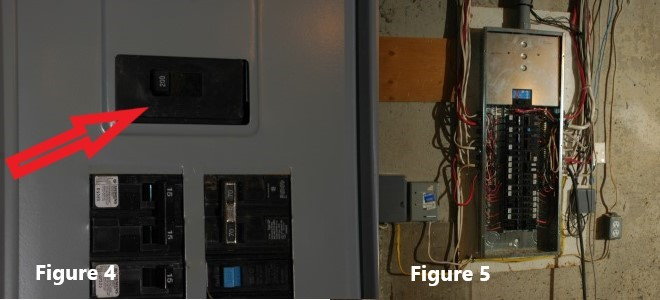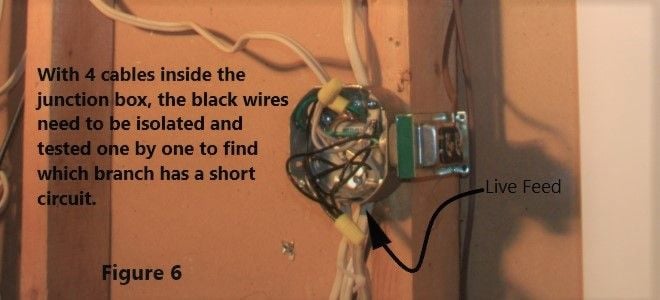Easy Ways to Trace a Short Circuit
Let's begin with an understanding of what an electric circuit really is. In order to have an operating electric circuit, three elements are required:
1. Source
Short Circuit Finding Kits on Amazon
The source is the means to apply a voltage to a path charging the electron particles which creates a flow of electron to constitute the "current" that enters the path at the "source" flowing through the load, and leaves by way of a "return" path back to the "earth ground." Battery-powered apparatuses such as cellphones, tablets, laptops, even cars, also require a return path to their DC source, and that's usually through their chassis-"ground".
2. Load
A load is one or a series of components that perform work whenever electricity is applied to it. A load can be a simple light fixture, to a more intricate assembly of thousands of resistors, semiconductors, inductors, capacitors, all connected together between the "source" and the "return" path.
3. Path
A path is created when conductors connect one side of a "load" to the "source" while connecting the other side to the "return". When charged electron particles find a path to flow from the source through the load and back to the source through the Neutral or the common ground. The loop is called an electrical circuit.
Example 1
When a 60 Watts lamp is working normally, the outlet is the source (120 volts), the light bulb is the load drawing 0.6 amps from the circuit, the other side of the lamp completes the circuit (Figure 1) by returning the charge through the Neutral line to the source.

Example 2
The 1200 Watts toaster in figure 2 is the load drawing 11 amps when plugged into a 120 volts "source" activating electron particles that "returns" to the source through the neutral wire (white).
It should be noted at this point that the neutral (white) side of the conductor being the return path to complete the circuit to the source doesn't carry current, but since a short circuit could put it there causing a potential hazard, the neutral conductor connected to the Earth Ground at the main breaker panel would cause the breaker to trip should the neutral become "live".
Had the cord been damaged like partially burnt as in Figure 3b, letting both of the wires touch together, plugging it in the outlet would create a new path with a very low resistance of under 2 Ohms resulting in a surge of over 55 amps of current, tripping the breaker rated at 15 or 20 amps.

Step 1 - Make the Distinction
Before starting, it has to be determined if dealing with a short circuit or a circuit overload which both result with a tripped circuit breaker.
If a 15 amp circuit is already running a microwave oven and a teapot and someone adds a toaster to the mix, the amps drawn will exceed the 15A rating and trip the breaker. Resetting the breaker returns it to normal.
When the same toaster is plugged by itself into the outlet, bare wires touching together will also trip the breaker but it will be impossible to reset as long as the bare wires keep touching. That's a Short Circuit (Figure 3b).
Step 2 - Assess Possible Causes
There are obvious signs and clues, such as smell, loose wires, frayed wires, burnt plastic, scorched metal, loose outlet, loose terminals, that must be constantly sought for while searching for the problem.
Step 3 - Trace a Household Short Circuit to its Source
When the breaker doesn't reset...
3a - Disconnect
unplugging everything from that breaker's circuit should tell if it's a shorted appliance or a shorted breaker circuit. If the breaker can then be reset, plug each and every appliance back in until one trips the breaker again. That appliance needs fixing.
3b - Check the Breaker
with everything unplugged, if it still doesn't reset, the problem resides in the breaker's circuit within the walls and to the panel. This circuit includes one breaker, perhaps light fixtures and most likely a few outlets.
The breaker should be checked first, but that will require using a battery-powered trouble light before switching OFF the main circuit breaker at the top of the electric panel and shutting all power off. This is to eliminate any risk of electrocution as the front cover with the access door has to be removed to expose the circuit breakers and the wiring into view.

3c - Remove the Wire
The wire connected to that breaker's terminal should be removed from its terminal connection and the breaker tried again for resetting. If it doesn't reset, the breaker is the problem. If it stays ON, keeping from touching any part of the panel, briefly turn ON and then back OFF, the main breaker to the panel and if the circuit breaker trips off with or without power, it needs to be replaced.
Safety Note: KEEP THE MAIN BREAKER OF THE PANEL TURNED OFF.
3d - Switch off Dedicated Breaker
With the breaker trusted in good condition, the breaker's wire is then screwed back on the breaker's terminal and the DEDICATED CIRCUIT BREAKER SWITCHED OFF to keep the power off that circuit while resuming the troubleshooting. The front cover of the panel can then be put and secured back in place and the main top circuit breaker can be turned back on.
3e - Check Local Outlet
With this done, the outlet closest to the breaker panel should be closely inspected by removing the faceplate. A multimeter set on continuity should be used to take a reading between the live (black) terminal and the grounded electrical box to make sure it's still at almost 0 Ω (short-circuited). A reading of ∝ (infinity) would indicate that the problem may be intermittent or was corrected while working at the outlet. It should be inspected further for deterioration marks and replaced if there is any damage.
3f - Disconnect Local Cable
Two or more cables inside that box would indicate how many fixtures or outlets are hooked up to this junction box. The black wire from each of them should be disconnected from each other and measured to find out if the short circuit lies between that point and the circuit breaker, or which of the other cables.

3g - Find the Damage
If it's towards the breaker, the short may have been caused by a rodent chewing the insulation off, scraped insulation while the cable was installed, or maybe it was perforated by a nail or screw or even a drill while doing some restoration project. If it's the case, the cable may need replacement or splicing, or even require assistance from a professional.
3h - Remove Fixture
If the short lies towards one of the other cables, the faceplate or the fixture itself should be removed from the affected box and the same test r epeated from Step 3e.
3i - Narrow Down the Location
This step is to determine if the short is between the previously tested outlet and this one, or towards the next outlet box. The short-circuited section is determined as soon as a 0 Ω reading occurs between the current outlet box and the previously tested one. Continue the procedure until that happens, then repair the faulty wiring or component.
When you purchase through links on our site, we may earn commissions at no cost to you.
Source: https://www.doityourself.com/stry/how-to-trace-a-short-circuit
Belum ada Komentar untuk "Easy Ways to Trace a Short Circuit"
Posting Komentar